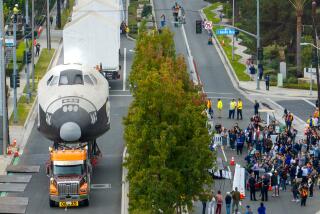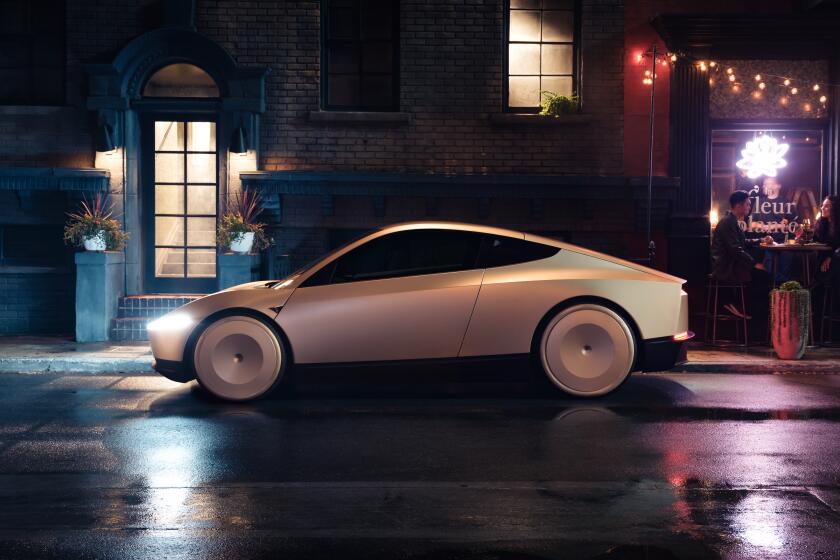SpaceX shows off capsule for ferrying astronauts to space station

SpaceX offered a glimpse of its next step toward delivering NASA astronauts to the International Space Station — a futuristic-looking capsule that nevertheless evoked the image of the Apollo spacecraft a generation ago.
At the company’s Hawthorne headquarters, Chief Executive Elon Musk told a throng of employees, aerospace industry leaders and journalists Thursday evening that the capsule would one day ferry people and equipment to and from orbit for the space agency.
“We wanted to take a big step in technology,” Musk said. “It really takes things to the next level.”
Before a massive white curtain dropped to unveil the capsule, a fast-moving, animated video showed the white, cone-shaped spaceship blasting into orbit atop a rocket. It zoomed to the space station, docked with it, then returned to Earth, gently touching down under its own rocket power.
“That’s how a 21st-century spaceship should land,” Musk said to a cheering crowd, noting that it would have the landing accuracy of a helicopter.
The capsule, dubbed Dragon V2, is designed to carry seven people and, unlike the Apollo craft, will be reusable, he said. The company expects to make its first manned test flight by the end of 2016.
Having the ability to reuse the spacecraft is a big factor, Musk said, because it will cut costs.
“As long as we continue to throw away rockets and spacecraft, we will never truly have access to space,” he said. “It’ll always be incredibly expensive.”
To emphasize the point, Musk asked the audience to imagine what would happen if a commercial jetliner were thrown away after each flight. Very few people would be able to afford the trip, he said.
Since NASA’s fleet of space shuttles were retired in 2011, the space agency has had no way to get its astronauts to the space station other than paying the Russian government $71 million a seat.
The arrangement with Russia, though, is showing some strain. This month, Russian Deputy Prime Minister Dmitry Rogozin suggested that his nation might halt U.S. access to its launch vehicles and may use the International Space Station without American participation.
From the outset three years ago, NASA wanted to turn over shuttling operations to American industry. The agency has handed out hundreds of millions of dollars in seed money to private companies to develop launch vehicles to take astronauts into outer space by 2017.
The NASA contracts set off a private space race. SpaceX has already sent a version of its craft into orbit in outer space and had it return intact.
At the time of the test in 2011, the Dragon capsule was empty, but it was a technological and financial feat that had been accomplished before only by government entities. The capsule has since delivered cargo to the space station three times.
SpaceX, short for Space Exploration Technologies Corp., has a $1.6-billion contract with NASA for a total of 12 deliveries.
The company won additional contracts from the space agency worth more than $500 million to develop its hardware to be astronaut-ready.
Others with contracts were Boeing Co., which has built nearly every manned spacecraft in U.S. history, and Sierra Nevada Corp. of Sparks, Nev., which is building a space plane that closely resembles a mini space shuttle.
SpaceX’s Dragon V2 spacecraft looks like a sleek, modern-day version of the Apollo capsules that astronauts used in trips to the moon in the 1960s. Those capsules splashed down in the ocean and couldn’t be reused.
SpaceX builds its Dragon capsules and Falcon 9 rockets in a vast complex in Hawthorne, where fuselage sections for Boeing’s 747 jumbo jets once were built. The company is expanding its complex, near Los Angeles International Airport, and has more than 3,000 employees.
More to Read
Inside the business of entertainment
The Wide Shot brings you news, analysis and insights on everything from streaming wars to production — and what it all means for the future.
You may occasionally receive promotional content from the Los Angeles Times.









